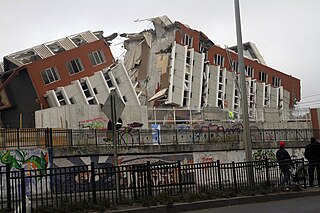Tectonic hazards/Earthquake engineering
| Educational level: this is a research resource. |

Earthquake engineering is the study of the behavior of building structures subject to earthquake impacts.[1]
Objectives of the earthquake engineering
[edit | edit source]The main objectives of earthquake engineering are:
- Understand the interaction between buildings and the ground.
- Foresee the potential consequences of strong earthquakes on building structures.
- Design, construct and maintain structures to perform at earthquake exposure up to the expectations and in compliance with building codes[2].
Tools
[edit | edit source]A properly engineered structure does not necessarily have to be extremely strong or expensive.
The most powerful and budgetary tools of earthquake engineering are vibration control technologies and, in particular, base isolation.
To verify experimentally the earthquake or seismic performance of a building structure[3], it may be put on a shake-table that simulates the earth shaking. The earliest shake-table experiments were performed more than a century ago [4]
Tsunami preparedness and protection
[edit | edit source]Tsunami or a chain of fast moving waves in the ocean caused, mostly, by powerful earthquakes is a very serious challenge for people's safety and for tsunami protection of buildings and civil infrastructure. Those waves can inundate coastal areas, destroy houses and even swipe away whole towns.[5]
Though tsunami can not be prevented, there are Tsunami warning system developed recently[6] which warn the population before the big waves reach the land to let them enough time to rush to safety.
| Look up earthquake engineering in Wiktionary, the free dictionary. |
| Wikibooks has a book on the topic of Seismic fitness. |
External links
[edit | edit source]- Tectonic hazards/Earthquake engineering at the Open Directory Project
- Earthquake Performance Evaluation Tool Online (EPETO)
- The George E. Brown, Jr. Network for Earthquake Engineering Simulation or NEES
- Vibration control videos
- Introduction to seismic fitness
References
[edit | edit source]- ↑ StruycturalPedia: Earthquake Engineering
- ↑ Berg, Glen V. (1983). Seismic Design Codes and Procedures. EERI. ISBN 0943198259.
- ↑ Valentin Shustov (2012), "Introduction to seismic fitness," http://nees.org/resources/4450.
- ↑ Omori, F. (1900). Seismic Experiments on the Fracturing and Overturning of Columns. Publ. Earthquake Invest. Comm. In Foreign Languages, N.4, Tokyo.
- ↑ USGS Poster of the Near the East Coast of Honshu, Japan Earthquake of 11 March 2011 - Magnitude 8.9
- ↑ Pacific Tsunamy Warning Center



